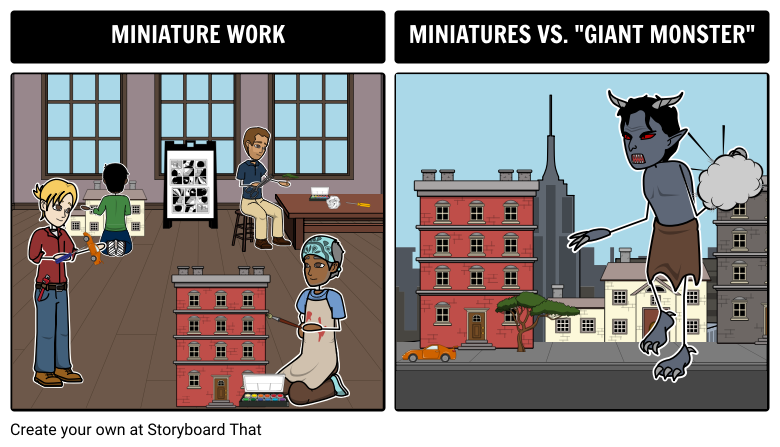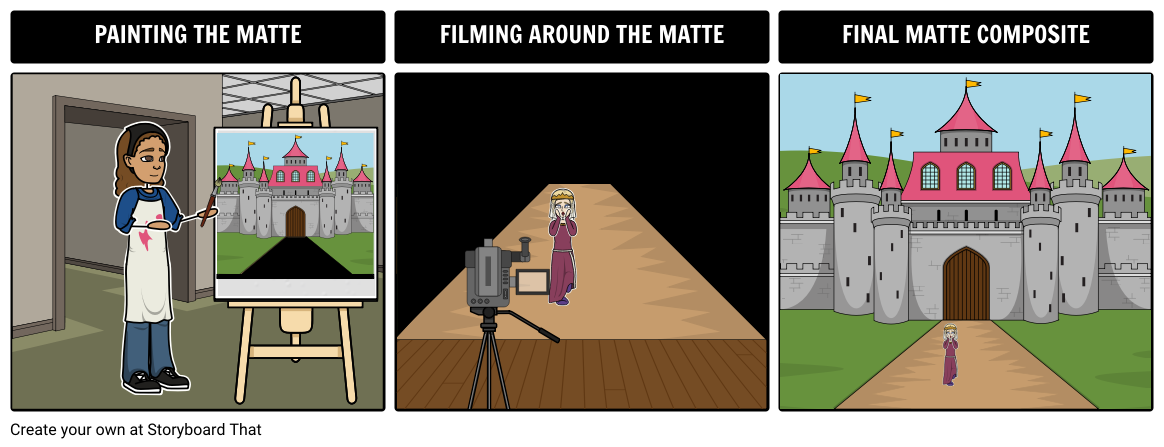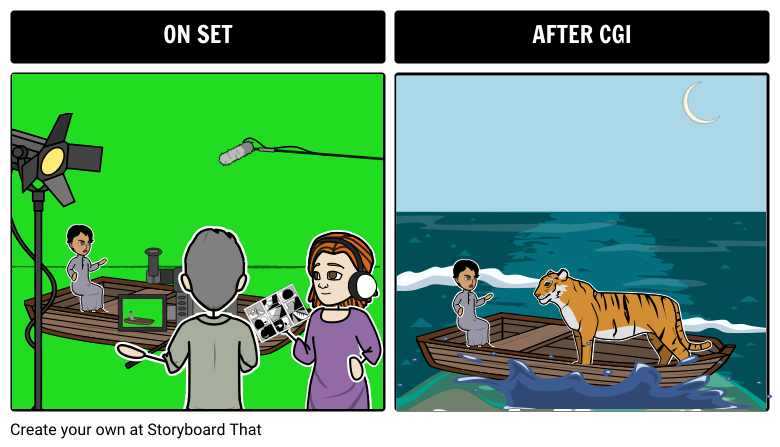The 6 Types of Special Effects in Movies

Special Effects
From the very beginning of the creative process, imagination is in play. Before a thing exists, it must be visualized in the mind. This happens in filmmaking all along the way. First the screenplay must be written, a necessary text exercise which does not allow for initial images. Then comes the storyboard. At this point, the first spark of what lies inside the artist’s mind comes to life. Sequences are graphically plotted out, providing key frames to the movie’s progress. It’s a revelation to register this with the eyes for the first time. After production gets into swing, it all gets real. A director must review props and wardrobe, audition and cast actors, scout and approve locations, and so forth. When that hot moment finally arrives – filming on set – you’re seeing your scenes once and for all, right? Well, not quite…
VFX. Enter the very broad area of special visual effects. VFX effects involve the use of digital technology to create, enhance, or modify visual elements that may be impractical, dangerous, or impossible to capture in-camera. Deep into film’s history, various techniques have been employed to insert imagery which was not filmed on set with things which were. The present and the not-yet-here will eventually share the screen. Special effects in movies are carefully crafted techniques used to create captivating and visually stunning moments that enhance the overall cinematic experience. These days, it’s common knowledge that there’s a little CGI (Computer Generated Imagery) in almost every Hollywood movie out there. But as far back as the 1890s, filmmakers were using clever methods to add elements to films via in-camera tricks, clever editing, and double exposures. Movie special effects encompass a wide range of techniques, including practical effects, computer-generated imagery (CGI), and visual effects (VFX), all working together to create awe-inspiring visuals on the big screen. Despite the fact that the digital age has made many of these traditional techniques much less common, virtually all of them are still in use today.
Examples of special effects in movies can range from explosive action sequences with intricate pyrotechnics to the seamless integration of fantastical creatures into live-action footage. Regardless of how special visual effects are accomplished, one central challenge has always been consistently presented to filmmakers: how can a scene be filmed when much of it cannot be seen at all? Again – digital film has narrowed this challenge to a great degree. But ultimately, actors need to play against characters and events which are not happening. The camera must record a negative space it does not yet know. And as always, the director must always be cognizant of what the final edited scene will look like, this time with nothing on set to look at. There’s a lot of ways to do this, but it varies depending on the techniques being employed. Digital compositing is a crucial process in special effects where multiple visual elements are combined, layer by layer, to create a cohesive and realistic final image. Below are some of the more common visual effects used in live action feature films, and how the filmmaker can approach mastering the art of “see you later.”
1. Animation
There’s a great deal of famous examples of films which have animated characters interacting with the “real” world in the movie. Classic examples include Disney films like Mary Poppins and Who Framed Roger Rabbit? Hand-drawn animated people and animals were added after the fact, while actors would have to play against props standing in for living counterparts. More recently, CGI has been used to fulfill this function, such as in The Life of Pi and Goosebumps. The good news for the filmmakers is that a well-crafted storyboard will serve as a guide in pre-production to get cast and crew familiar with the idea of what the final frames and sequences will look like. When combined with character illustrations and production design renderings, a full picture can be grasped to help translate not only the action, but the mood of what will be added in later. Voice actors can also be present on set to add an aural element which can be especially beneficial to the people giving their lines on set.
2. Miniatures
One of the oldest tricks in the special visual effects book is the use of miniatures. Traditionally, this meant building scale models of environments to represent very large sets like entire cities, massive vehicles, huge structures, and so forth. As far back as the Silent Era, films like Metropolis used miniatures to represent a city of the future, complete with moving parts. Actors would have to look out at nothing and try and make us believe they were beholding a jaw-dropping scenario. While the first look at miniatures occurs in the storyboard, it’s in the production design process that filmmakers get the first real look at the details of the models to be built. Once the craftsmen get down to the business of building them, the whole crew can have a real look at what will be appearing on screen. While not every production can have access to completed miniatures prior to filming on set, even early examples should be shared with key production staff and cast. There’s a tactile element to standing in front of finely constructed miniatures which really sinks into the eyeballs. You can even really touch them (carefully!). Getting face time with what will sit in on screen later will benefit the production.

3. Matte Paintings
Another time-honored method to add large-scale environments is the Matte Painting. There’s a few different ways to do it, but essentially, an artist paints a highly detailed photo-realistic set piece, often on a massive scale, to depict what a set could not. Actors are blocked into the frame so as to not break the borders of the matte which will be added later. The Wizard of Oz employed them to great effect, especially when Dorothy and the gang get their first look of The Emerald City in the distance. Star Wars also used them in shots like the Death Star’s loading bay – those hundreds of Storm Troopers were literally drawn in! Storyboards are often key to the initial understanding of how these frames will look when the images are integrated, but that all becomes much more clear with production design. In the past, these specialized paintings might not be ready to be seen by the time cameras roll on set. These days, digital mattes are the most common, and early access to the visuals can get the whole crew on the same page.

4. Stop Motion
There’s a certain charm to stop motion animation, even if the final product cannot mask what it is. From old classics like King Kong to 2015’s Oscar-Nominated Anomalisa, there’s a texture to exposing fully posable models one frame at a time that CGI can never recreate. Figures such as dolls, toy vehicles, clay, or just about any raw material a filmmaker may wish to animate are painstakingly filmed in dozens of poses per second of film in order to recreate the illusion of motion. Early test trials can give cast and crew a very concrete idea of what will be appearing next to them on screen in post-production, offering a grounding experience where before they faced only a blank space on set. Filmmakers can prepare the production even earlier by sharing storyboards and character design in advance of the stop motion photography. And since it’s common for stop motion techniques to also employ mattes, miniatures, and even animation, a much deeper source of reference is often available to prep everyone involved for their part in the final product.
5. Doubling
Everybody seems to love twins. And clones. Or maybe robots with a striking resemblance to a protagonist. Whatever the case, every time you see a double of a character on screen, it is almost invariably the technique of doubling which you are watching (as opposed to using real-life twins, triplets, etc.). And in the digital age, doubling can easily go haywire, the way Agent Smith’s multiple avatars seem to be endlessly multiplying in the Matrix films. Doubling puts the burden squarely upon the actor: how does one play against oneself? Early on in pre-production, a storyboard can help a cast devise a physical strategy for expressing the juxtapositions of its various selves. In the past, previously-recorded dialogue or an actor providing countering dialogue made for great assistance to the actor doubling their part. The digital age allows for instantaneous replay and integration of doubled actors, so they can literally watch themselves act against themselves right there on set if need be. But as always, doing early tests with the tech on hand can do an even better job on performance prep.

6. CGI
The most talked-about special visual effect is also the one that people don’t seem to appreciate the depths of enough. Computer Generated Imagery can literally put anything up on a screen – from vast landscapes that don’t even exist to huge armies filled with digital people instead of extras on set. Digital tech allows scenes to be literally painted and animated in any way the filmmaker chooses. And, if so desired, can replace every other form of effect discussed here so far. Even so, there are many reasons to still use miniatures, mattes, and models, and so often CGI is mixed in with other media to make film sequences. What’s also nice about the process is that the “missing” elements can often be interacted with on set via an integrated composite on a monitor. This gives cast and crew an enormous advantage when filling in the gaps missing in front of the camera. But before that even happens, the filmmaker must be very sure to ask for what they want. CGI is an expensive process requiring great expertise and a large technical crew operating expensive software and hardware. While there is the luxury of “erasing” results one does not like, there are enormous cost overruns at risk when making such mistakes. Better to use cheaper methods earlier. Tools like storyboards, production design, and test clips should never be disposed of, even if digital composites will be available on set. Getting everything right from the get-go can save filmmakers a lot of time, money, and headaches.

Special Effects vs Visual Effects: Distinguishing Practical from Digital
In the realm of filmmaking, special effects encompass practical techniques like explosions and animatronics, while visual effects utilize digital technology to create or enhance elements that are difficult or impossible to achieve practically. Special effects focus on in-camera tricks and physical manipulation, while visual effects extend beyond reality, employing CGI and digital compositing. Together, these disciplines combine to deliver captivating visual spectacles that push the boundaries of imagination in the industry.
How to Make a Movie with Special Effects
Understand the Basics
Familiarize yourself with the various types of special effects, such as motion capture, digital effects, optical effects, and practical effects, to grasp their creative potential.
Utilize Green Screens
Incorporate green screen technology to composite images, allowing for seamless integration of live-action footage with computer-generated elements.
Embrace Technology
Equip your team with the latest computer software and VFX tools to take advantage of existing effects technology and enhance visual storytelling.
Collaborate with VFX Artists
Work closely with skilled visual effects artists who specialize in motion capture, computer animation, and composite images to bring your vision to life.
Combine Motion Picture Techniques
Integrate motion capture technology with traditional movie camera techniques to create dynamic and visually compelling scenes.
Explore Creative Freedom
In the modern filmmaking landscape, leverage special effects to explore genres like science fiction and animated films, opening new realms of creative freedom.
Master Mechanical Effects
Incorporate practical effects and atmospheric effects to enhance realism and authenticity in specific scenes.
Stay Updated
Learn the latest advancements in VFX software and technology to stay ahead in the fast-paced visual effects industry.
Learn from Influential Films
Study and analyze the techniques used in most influential films known for their groundbreaking special effects to gain insights and inspiration.
Emphasize Visual Storytelling
Use special effects as a storytelling tool, enhancing the narrative and emotional impact of your movie.
About the Author

Argentinean-born New Yorker Miguel Cima is a veteran of the film, television, and music industries. An accomplished writer, filmmaker, and comic book creator, Miguel's movie, Dig Comics, won Best Documentary at the San Diego Comic Con and was selected for Cannes. He has worked for Warner Bros. Records, Dreamworks, MTV, and more. Currently, Miguel creates content for multiple platforms and media. His formal education came from New York University, where he earned a BFA in film. World traveler, culture junkie and major foodie, he is happily unmarried to the same gal since the mid 2000s, devoted to his family & friends, and slavishly serves his true masters - two dogs and a cat.
Frequently Asked Questions about Special Effects in Film
When exploring film visual effects, which are the two most likely to be discussed?
CGI (computer-generated imagery) and practical effects are excellent examples to discuss two visual effects that have been used in popular films.
CGI (Computer-Generated Imagery): CGI is a digital technique that allows filmmakers to create and manipulate visuals using computer software. It has revolutionized the film industry by enabling the creation of lifelike creatures, fantastical environments, and spectacular action sequences. Blockbuster films like "Avatar," "Avengers: Endgame," and "Jurassic Park" have showcased the immense potential of CGI in bringing imaginative worlds and breathtaking visuals to the screen. Through CGI, filmmakers can seamlessly blend live-action footage with digitally created elements, resulting in seamless integration and realistic visual experiences.
Practical Effects: Practical effects refer to the physical techniques used on set to create visual illusions. They involve using real props, makeup, models, miniatures, pyrotechnics, animatronics, and other tangible methods. Practical effects have a long history in filmmaking and have been responsible for some iconic moments in cinema. From the groundbreaking creature effects in "Alien" to the mind-blowing stunts in the "Mission: Impossible" series, practical effects provide a tangible and visceral experience for both actors and audiences. Filmmakers often combine practical effects with CGI to achieve a seamless blend of real-world elements and digital enhancements.
What are some famous movies known for their groundbreaking visual effects?
Several movies have achieved fame for their groundbreaking visual effects, revolutionizing the industry and raising the bar for future films. "Jurassic Park" (1993) astounded audiences with its realistic portrayal of dinosaurs using computer-generated imagery (CGI). "The Matrix" (1999) introduced the iconic bullet time effect, reshaping action sequences. "Avatar" (2009) pushed the boundaries of motion capture and CGI to create a visually immersive alien world. "Inception" (2010) showcased mind-bending visual effects, including zero-gravity fights and city-folding sequences. "Gravity" (2013) depicted the vastness of space through seamless integration of live-action and CGI. "Interstellar" (2014) blended practical effects, miniatures, and CGI to explore space travel and black holes. These movies have left a lasting impact, inspiring future filmmakers to push the boundaries of visual effects.
What is VFX in film?
VFX stands for "Visual Effects" in film. It refers to the use of digital technology, computer-generated imagery (CGI), and other visual elements to enhance or create visual sequences that are difficult or impossible to achieve through practical means alone. VFX in film encompasses a wide range of techniques, including creating realistic environments, animating fantastical creatures, simulating natural phenomena like fire and water, and adding visual enhancements to live-action footage. VFX artists play a crucial role in the filmmaking process, using specialized software and techniques to bring imaginative worlds and extraordinary visuals to life on the big screen.
© 2024 - Clever Prototypes, LLC - All rights reserved.
StoryboardThat is a trademark of Clever Prototypes, LLC, and Registered in U.S. Patent and Trademark Office
